 W
WDutch Golden Age painting is the painting of the Dutch Golden Age, a period in Dutch history roughly spanning the 17th century, during and after the later part of the Eighty Years' War (1568–1648) for Dutch independence.
 W
WBaroque painting is the painting associated with the Baroque cultural movement. The movement is often identified with Absolutism, the Counter Reformation and Catholic Revival, but the existence of important Baroque art and architecture in non-absolutist and Protestant states throughout Western Europe underscores its widespread popularity.
 W
WHaerlempjes refer to a specific genre of landscape painting that includes a view of Haarlem. It is used most often to refer to Jacob van Ruisdael's panoramic views of the city, but the term is derived from mentions in Haarlem archives as a type of painting included in household inventories. The diminutive suffix "pje" would denote a small, cabinet-sized painting, but even the largest landscapes may be referred to as Haerlempjes today.
 W
WMerry company is the term in art history for a painting, usually from the 17th century, showing a small group of people enjoying themselves, usually seated with drinks, and often music-making. These scenes are a very common type of genre painting of the Dutch Golden Age and Flemish Baroque; it is estimated that nearly two thirds of Dutch genre scenes show people drinking.
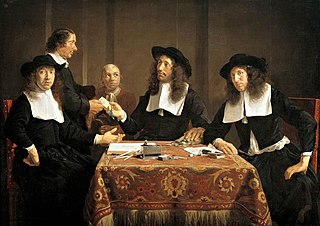 W
WA regents group portrait, is a group portrait of the board of trustees, called regents or regentesses, of a charitable organization or guild. This type of group portrait was popular in Dutch Golden Age painting during the 17th century, and in the 18th century. They were intended to be hung in the regentenkamer, the regents' meeting room, or another prominent location in the institution.
 W
WStill Life Paintings from the Netherlands 1550–1720, is a 1999 art exhibition catalog published for a jointly held exhibition by the Rijksmuseum Amsterdam and Cleveland Museum of Art. The catalog included detailed discussions of 80 paintings from various collection holders, that together give an overview of the best genres in Dutch still-life paintings, namely kitchen piece (keukenstuk), fruit still-life, (fruitstuk), floral still-life (blommetje), breakfast piece (ontbijtje), vanitas, hunting piece (jaagstuk), and show piece (pronkstilleven). The catalog was organized by type, but also loosely by time period, starting with the earliest works.
 W
WAllegory of Vanity and Repentance is a 1616 oil painting by the Dutch artist Cornelis van Haarlem. It is now in the Musée des Beaux-Arts of Strasbourg, France. Its inventory number is 1969. The painting's lesser known and lesser used title is Human Love and Divine Love; it was also known in the past as Pagan Life and Christian Life. Although the Dutch Republic was mostly Protestant in 1616, van Haarlem's painting was made for a Catholic patron.
 W
WAn Astrologer is a 1663 oil on panel painting by the Dutch artist Cornelis Bega, now in the National Gallery, London, to which it was presented by Martin Henry Colnaghi in 1896.
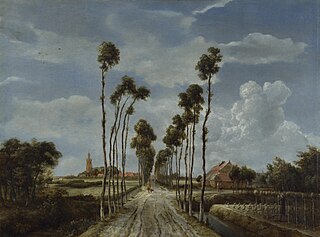 W
WThe Avenue at Middelharnis is a Dutch Golden Age painting of 1689 by Meindert Hobbema, now in the National Gallery, London. It is in oil on canvas and measures 103.5 by 141 centimetres. It shows a road leading to the village of Middelharnis on the island of Goeree-Overflakkee in the Maas delta in South Holland, the Netherlands.
 W
WBattle Between Carnival and Lent is an oil painting by Dutch artist Jan Miense Molenaer, located in the Indianapolis Museum of Art, which is in Indianapolis, Indiana. Painted roughly 1633–1634, it depicts a brawl between rowdy peasants, representing Carnival, and a group of monks, representing Lent. The rowdy combatants are armed with comical implements representing their sides, such as a peasant with a beer tankard battling a monk armed with fish.
 W
WThe Blackcurrant Pie is a 1641 still life painting by the Dutch artist Willem Claesz. Heda. It is now in the Musée des Beaux-Arts of Strasbourg, France. Its inventory numbers is 1745.
 W
WThe Castle of Muiden in Winter is a 1658 oil on canvas painting by Jan Abrahamsz Beerstraaten, now in the National Gallery, London, which bought it in 1890. It shows Muiden Castle near Amsterdam, with several figures ice skating in the foreground.
 W
WThe Chess Players is a c.1670 oil on canvas painting by Cornelis de Man, now in the Museum of Fine Arts in Budapest, Hungary as Inventory Number 320. It entered the collection in 1871.
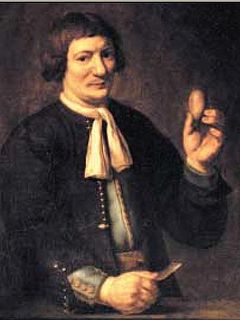 W
WJan de Doot is the subject of a painting from 1655 by Carel van Savoyen. It shows De Doot, a smith, holding in one hand a kitchen knife, and in the other a large bladder stone the size and shape of an egg, set in gold. This 17th-century Dutch blacksmith is said to have performed a successful lithotomy on himself in 1651. The painting is part of the Portrait Collection of the Laboratory of Pathology, which is part of the University of Leiden.
 W
WDutch Ships in a Calm Sea is a 1665 oil-on-canvas painting by Dutch marine artist Willem van de Velde the Younger (1633–1707). The son of Willem van de Velde the Elder, who also specialized in marine art, he was first instructed by his father and later by Simon de Vlieger.
 W
WEsther and Mordecai is a 1685 oil on panel painting by Arent de Gelder, a pupil of Rembrandt. It is now in the Museum of Fine Arts in Budapest.
 W
WAn Evening River Landscape with a Ferry is a 1643 painting by the Dutch painter Jan van Goyen. The painting was bought in 1890 in Paris by Wilhelm von Bode. It is now in the Musée des Beaux-Arts of Strasbourg, France. Its inventory number is 221.
 W
WThe Fall of the Titans is an oil painting of the Titanomachy by the Dutch painter Cornelis van Haarlem in 1588–1590. It measures 239 × 307 cm (94 × 121 in). The work is in the collection of the Statens Museum in Copenhagen, Denmark. It is an ambitious work of the Haarlem Mannerists, and a display of the artist's ability to devise and depict a large number of varied poses for the male nudes.
 W
WThe Floating Feather is the commonly used name for an oil-on-canvas painting by Dutch artist Melchior d'Hondecoeter, properly titled A Pelican and Other Birds Near a Pool. The fine detail of the feather floating on the pond led to the "official" title being quickly supplanted.
 W
WFlowers with Two Lizards is a 1603 painting by Roelant Savery, now in the Centraal Museum in Utrecht. It and a near-identical version by the same artist are the two earliest surviving floral still lifes from the Northern Netherlands.
 W
WThe Gouden Bocht on the Herengracht in Amsterdam, Seen from the West is a 1672 painting by the Dutch artist Gerrit Berckheyde (1638-1698). As its title suggests it shows a section of the Herengracht canal.
 W
WThe Gun Salute is a c.1680 oil on canvas painting by Willem van de Velde the Younger, showing a ship of the Dutch navy firing a gun salute. It and its pendant work The Gust of Wind were painted after his arrival in England around 1672, where he later succeeded his father as court painter to Charles II of England.
 W
WIsaac Blessing Jacob is a 1642 religious painting by Gerbrand van den Eeckhout. It shows Jacob kneeling at the bed of his blind father Isaac under the watchful eye of his mother Rebecca as he receives his brother Esau's blessing. It is in the collection of the Metropolitan Museum of Art.
 W
WThe Lace Maker (1662) is an oil on canvas painting by the Dutch painter Caspar Netscher. It is an example of Dutch Golden Age painting and is part of the Wallace Collection.
 W
WThe Little Bridge is an undated landscape painting by the Dutch painter Gillis Rombouts. It is now in the Musée des Beaux-Arts of Strasbourg, France. Its inventory number is 423.
 W
WMerry Company is a c.1620-1622 painting by the Dutch artist Willem Pieterszoon Buytewech, now in the Museum of Fine Arts in Budapest. It belongs to the merry company sub-genre of the genre painting.
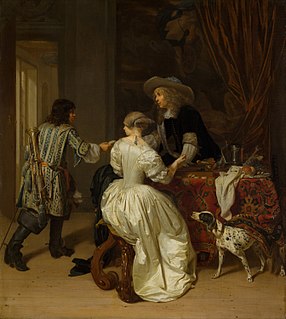 W
WThe Messenger is a 1674 oil painting by Johannes Verkolje which is in the collection of the Mauritshuis, The Hague, Netherlands.
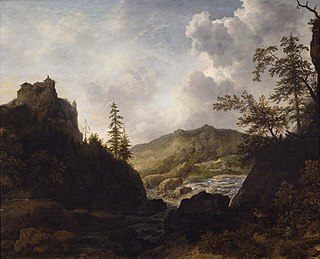 W
WNordic Landscape with a Castle on a Hill is a circa 1660 oil painting by the Dutch Golden Age painter Allaert van Everdingen. It is on display in the Musée des Beaux-Arts of Strasbourg, France. Its inventory number is 560.
 W
WPeasants with Cattle by a Ruin is a 1650-1697 painting by Abraham Begeyn, now in the National Gallery, London. It shows a rural scene with a capriccio-style ruin.
 W
WPerseus Freeing Andromeda is a 1611 oil on canvas painter by the Dutch Mannerist painter Joachim Wtewael. Since 1982 it has been in the collection of the Louvre in Paris. A preparatory drawing for it also survives in the Albertina in Vienna, reprising the pose in the same artist's St Sebastian Bound to a Tree for Andromeda. In the final painting he used a less curving and more supple pose for Andromeda.
 W
WPortrait of a Clergyman is a c.1650 oil on canvas painting long attributed to Rembrandt but now attributed to Helmich van Thweenhuysen II, a Dutch painter active in Gdansk. It has been in the National Museum in Wrocław since 1947.
 W
WPortrait of a Woman is a 1641 oil on panel painting by the Dutch artist Hendrick Cornelisz. van Vliet, now in Room 249 of the Hermitage Museum. Its subject is unknown, but a signature, date and inscription at bottom left shows she was thirty years old at the time - this is corroborated by her costume, which was in fashion in the 1640s. I A Sokolova, curator of Dutch paintings in the Hermitage, notes that “in the modeling of the face, monochrome parallel strokes in form are clearly visible, which have emerged as a result of the thinned upper paint layer”.
 W
WPortrait of Abraham Grapheus is a 1620 painting by Cornelis de Vos, now in the Royal Museum of Fine Arts, Antwerp. Its subject was a fellow member of Antwerp's Guild of St Luke, of which de Vos was then dean. The work was taken to Paris by the French occupiers of the Southern Netherlands between 1794 and 1796. It returned to Antwerp in 1815, where it hung in the Antwerp Academy.
 W
WPortrait of Don Miguel de Castro, Emissary of Congo is a 1643 painting by the Dutch Golden Age painter Jasper or Jeronimus Becx. It was earlier attributed to Albert Eckhout.
 W
WPortrait of Maurice, Prince of Orange is an oil on panel portrait produced sometime between 1613 and 1620 by Michiel van Mierevelt. It shows Maurice, Prince of Orange. It was commissioned by the States General of the Netherlands. According to an English traveller, it was hanging in the assembly room of the States General in 1707.
 W
WPortrait of Stephan Geraedts, Husband of Isabella Coymans is an oil on canvas painting by Antwerp-born Dutch Golden Age painter Frans Hals. The painting was originally part of a couple of pendant wedding portraits. Hals probably painted the present portrait, Stephanus Geraerdts', alderman in Haarlem, and the accompanying portrait of the latter's wife Isabella Coymans around 1650-1652, six or seven years after their marriage in 1644. Isabella's portrait is now in a private collection in Paris.
 W
WPortrait of a Young Man with a Gold Chain is an oil painting usually attributed to the Dutch painter Rembrandt. Signed and dated 1635, it was traditionally regarded as a self-portrait, although contemporary criticism tends to challenge this hypothesis.
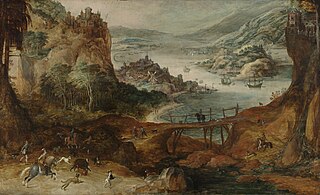 W
WRiver Landscape with a Boar Hunt is a c.1600 painting by the Dutch artist Joos de Momper, now in the Rijksmuseum in Amsterdam. The artist uses a high point of view as in Altdorfer's The Battle of Alexander at Issus (1528-1529) and Brueghel's The Hunters in the Snow (1565). Later he mostly used a lower point of view, establishing what would become a typical feature of 17th century Dutch and Flemish landscapes such as Windmill at Wijk bij Duurstede.
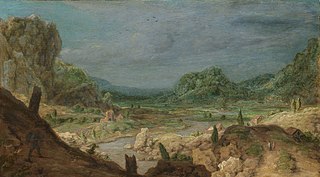 W
WThe River Valley is a c.1626-1630 painting by the Dutch artist Hercules Seghers. It is now in the Rijksmuseum in Amsterdam, which acquired it in May 1931.
 W
WThe St Adrian Civic Guard is a 1612 militia group portrait painting by the Dutch artist Cornelis Engelsz. It is now in the Musée des Beaux-Arts of Strasbourg, France. Its inventory number is 364.The painting was bought from Charles Sedelmeyer in 1895 by the director of the Strasbourg museum, Wilhelm von Bode, and entered the collections two years later. As of 2014, it was the only Dutch painting of that kind in a French museum.
 W
WStill Life with a Chinese Porcelain Jar is a 1669 oil painting by Dutch artist Willem Kalf, located in the Indianapolis Museum of Art, which is in Indianapolis, Indiana. It is a sumptuous still life displaying the sort of costly wares that flowed through the Netherlands during its heyday as a trade center.
 W
WStill Life with a Silver Jug is a 1655–1660 still life painting by the Dutch artist Willem Kalf (1619-1693), now in the Rijksmuseum in Amsterdam, which purchased it at the sale of Albertus Jonas Brandt's collection in Amsterdam on 29 October 1821.
 W
WStill Life with a Turkey Pie is a 1627 still life painting by the Dutch painter Pieter Claesz, now in the Rijksmuseum in Amsterdam. It was in the collection of Baroness Cecilia-Maria van Pallandt at Keukenhof Castle from 1881. Her descendants sold it to the Hague-based art dealer S.Neistad in 1974 for 300,000 guilders. He sold it onto its present owners later the same year for 832,000 guilders.
 W
WStreet Musicians at the Door is an oil painting depicting members of a wealthy family interacting with two begging musicians at the door of their house. Dutch Golden Age artist Jacob Ochtervelt (1634–1682) painted it in Rotterdam in 1665, as an example of the "entrance hall painting", a genre he pioneered. It is in the collection of the Saint Louis Art Museum.
 W
WThe Threatened Swan is an oil painting of a mute swan made around 1650 by Dutch Golden Age painter Jan Asselijn. The work is in the collection of the Rijksmuseum in Amsterdam in the Netherlands.
 W
WThree Regentesses and the Binnenmoeder of the Leprozenhuis of Amsterdam is a 1624 oil on panel painting by Werner van den Valckert, now in the Rijksmuseum collection in Amsterdam. It belongs to the regents group portrait genre.
 W
WTimothy with his Grandmother Lois or The Prophetess Anna Teaching a Child is a 1650 or c.1654 oil on canvas painting, attributed to Rembrandt until 1910 but since 1924 thought to be by Willem Drost. Its two titles refer to Timothy, Lois and Anna. It is now in the Hermitage Museum.
 W
WTwo Calves, a Sheep and a Dun Horse by a Ruin is a c. 1665 oil on panel painting by Dirck van den Bergen, previously misattributed to Adriaen van de Velde. It is now in the National Gallery, London.
 W
WThe Young Bull or The Bull is an oil painting of a bull by Paulus Potter. It is in the collection of the Mauritshuis in The Hague in the Netherlands.
 W
WYoung Woman Stringing Pearls is a 1658 painting by the Dutch artist Frans van Mieris the Elder. It has been in the collection of the Musée Fabre in Montpellier since 1836.
 W
WZerubbabel Before Darius is an oil on oak panel painting by Nikolaus Knüpfer, now in the Hermitage Museum. It was dated to after 1644 by Jo Saxton, a date also accepted by the work's owner. The work is signed at the foot of the throne on the left hand side. The frame is significantly damaged and the bottom right of the panel is chipped away.
 W
WThe Zuiderzeedijk at Schardam is a painting by Matthias Withoos, marking a breach in the dike near the village of Schardam in the Province of North Holland. It shows repair work being carried out to the breach between Schardam and Scharwoude - it is thought to be the only painting of that period to show such repairs.